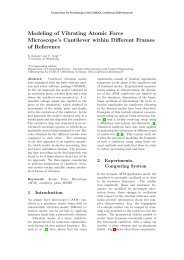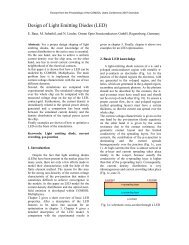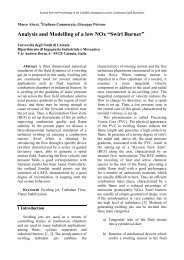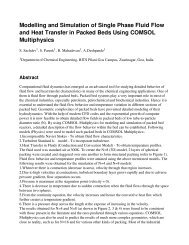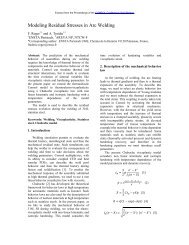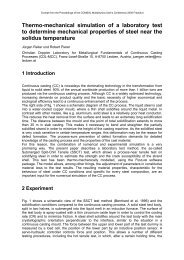Rheology model - COMSOL.com
Rheology model - COMSOL.com
Rheology model - COMSOL.com
You also want an ePaper? Increase the reach of your titles
YUMPU automatically turns print PDFs into web optimized ePapers that Google loves.
Comsol Conference, Milano October 14 – 16, 2009<br />
<strong>Rheology</strong> <strong>model</strong>ing of a<br />
Multiphase Detergent Processing<br />
Vincenzo Guida<br />
Pomezia F&HC R&D
Background<br />
5 micron<br />
100 micron
<strong>Rheology</strong> of FP<br />
Equilibrium parameters definition 0Pa 001-0002f<br />
0.1 Pa applied stress<br />
4.500<br />
10.00 10.00<br />
4.000<br />
3.500<br />
viscosity (P Pa.s)<br />
3.000<br />
2500 2.500<br />
2.000<br />
1.500<br />
1 sec-1 constant shear experiment<br />
(lab made unsheared sample)<br />
G' (Pa)<br />
G'' (Pa)<br />
1.000<br />
0.5000<br />
0<br />
0 20.00 40.00 60.00 80.00 100.0 120.0 140.0<br />
time (s)<br />
0 0<br />
1.000 ang. frequency (rad/s)<br />
50.00<br />
Thixotropic Material<br />
Under flow<br />
Weak elastic gel at rest
Detergent processing<br />
Shear<br />
Shear
Industrial problems for detergents<br />
manufacturing<br />
• Predict flow of detergents<br />
– Size pumps and pipelines<br />
– Calculate pressure drop in mixing devices,<br />
packing nozzles, manifold etc…<br />
• Predict finished product properties<br />
– Ahi Achieve a dt determined dmicrostructure<br />
t<br />
– Predict rheology, stability, apperance
Flow problem: <strong>model</strong>ing<br />
thixotropy
Product rheology<br />
Viscosity Curve<br />
100<br />
Viscos sity (Pa.s)<br />
10<br />
1<br />
0.01 0.1 1 10 100<br />
0.1<br />
Shear Rate (sec-1)
Thixotropy<br />
Viscosity evolution versus time at shear<br />
1000<br />
100<br />
Viscosity at 0.1 sec-1<br />
Viscosity at 1 sec-1<br />
Viscosity at 10 sec-1<br />
Viscosity at 100 sec-1<br />
Viscosit ty (Pa*sec)<br />
10<br />
1<br />
01 0.1<br />
0.01<br />
0 2 4 6 8 10 12 14 16<br />
Time (min)
Thixotropy experimental investigation<br />
Viscosity at 0.1 sec-1 after 15 minutes at a given shear stress<br />
60<br />
50<br />
Viscosity (Pa.s)<br />
40<br />
30<br />
20<br />
10<br />
0<br />
0 20 40 60 80 100 120<br />
Applied Shear stress (Pa)<br />
<br />
<br />
<br />
<br />
0<br />
<br />
<br />
c<br />
eq<br />
<br />
1<br />
<br />
1<br />
<br />
<br />
critic
Thixotropy experimental investigation<br />
Viscosity at 0.1 sec-1 after x minutes at high stress<br />
100<br />
90<br />
80<br />
Viscosit ty (Pa*sec)<br />
70<br />
60<br />
50<br />
40<br />
30<br />
20<br />
10<br />
20 Pa<br />
50 Pa<br />
80 Pa<br />
0<br />
0 2 4 6 8 10 12 14 16<br />
Time at high stress (minutes)
<strong>Rheology</strong> <strong>model</strong><br />
<br />
<br />
K <br />
<br />
K K c<br />
<br />
K0<br />
K<br />
dc<br />
<br />
( a b <br />
) <br />
dt<br />
<br />
<br />
1<br />
ceq<br />
<br />
<br />
<br />
<br />
<br />
<br />
<br />
<br />
1<br />
<br />
crit <br />
n<br />
<br />
<br />
n<br />
<br />
c<br />
<br />
c eq<br />
<br />
<br />
<br />
Modification of Moore’s <strong>model</strong>
3D implementation in Comsol<br />
Momentum balance<br />
<strong>Rheology</strong> constitutive equation<br />
Conservation law for connectivity<br />
i<br />
<br />
<br />
<br />
k <br />
<br />
1<br />
2<br />
2 2 2<br />
2<br />
2<br />
4u<br />
4v<br />
4w<br />
<br />
2u<br />
v 2u<br />
w 2v<br />
w <br />
x<br />
y<br />
R (<br />
a b<br />
)<br />
z<br />
y<br />
x<br />
<br />
<br />
<br />
<br />
<br />
c <br />
ceq<br />
z<br />
<br />
<br />
<br />
x<br />
z<br />
y<br />
2<br />
n
Fluid dynamics simulation
Simulation Results
Microstructure problem:<br />
<strong>model</strong>ing gelation
After Processing<br />
25.00<br />
22.50<br />
20.00<br />
17.50<br />
25.00<br />
22.50<br />
20.00<br />
17.50<br />
Gelation<br />
happens<br />
G' (P Pa)<br />
15.00<br />
12.50<br />
10.00<br />
7.500<br />
5.000<br />
2.500<br />
0<br />
Time sweep oscillation 10 Hz 0.1 Pa<br />
Lab made Product sheared 30 seconds at 100 Pa<br />
0<br />
0 25.00 50.00 75.00 100.0 125.0 150.0 175.0 200.0<br />
time (s)<br />
15.00<br />
12.50<br />
10.00<br />
7.500<br />
5.000<br />
2.500<br />
G'' (Pa)<br />
Destructuring rate 30Pa Destructuring 10min 001-0002o rate 30Pa 10min 001-0002o, Time sweep step<br />
100.0 100.0<br />
G' (Pa)<br />
10.00<br />
10.00<br />
G'' (Pa)<br />
Time sweep oscillation 10 rad/sec 0.1 Pa<br />
Gelation<br />
Does not happen<br />
Lab made Product sheared 600 seconds at 30Pa<br />
1.000 1.000<br />
0 200.0 400.0 600.0 800.0 1000<br />
time (s)
Rheological Characterization<br />
Constant Stress Flow<br />
Time Sweep Oscillation<br />
= 5, 10, 30. 50 100 Pa<br />
t =, 30, 60, 180, 600 sec<br />
= 0 -900 sec<br />
25<br />
G' versus applied shear stress (10 Minutes) before and after<br />
recovery<br />
25<br />
23<br />
G' after recovery versus time for different applied shear stress<br />
10 Pa<br />
30 Pa<br />
50 Pa<br />
100 Pa<br />
20<br />
Lab G'<br />
Lab G' after 15 minutes<br />
21<br />
G'<br />
15<br />
G' (Pa)<br />
19<br />
17<br />
10<br />
15<br />
5<br />
13<br />
11<br />
0<br />
0 20 40 60 80 100 120<br />
Applied Stress<br />
9<br />
0 10 20 30 40 50 60 70<br />
Shear Time
Empirical <strong>model</strong>ing<br />
X1<br />
Fraction of<br />
t d<br />
X2<br />
Fraction of<br />
X3<br />
Fraction of<br />
connected<br />
rods<br />
not connected<br />
rods<br />
nematic<br />
rods<br />
1 )<br />
( X<br />
X<br />
b<br />
dX<br />
2<br />
2<br />
2<br />
1<br />
1<br />
1<br />
1<br />
)<br />
(<br />
)<br />
(<br />
)<br />
(<br />
X<br />
b<br />
a<br />
X<br />
a<br />
X<br />
b<br />
a<br />
dX<br />
X<br />
a<br />
X<br />
b<br />
a<br />
dt<br />
d<br />
<br />
<br />
<br />
<br />
<br />
<br />
<br />
<br />
<br />
<br />
<br />
<br />
<br />
<br />
<br />
<br />
<br />
2<br />
1<br />
3<br />
2<br />
3<br />
3<br />
2<br />
2<br />
1<br />
1<br />
1<br />
1<br />
)<br />
(<br />
)<br />
(<br />
X<br />
X<br />
X<br />
X<br />
b<br />
a<br />
X<br />
a<br />
X<br />
b<br />
a<br />
dt
Estimating Kinetics from <strong>Rheology</strong><br />
2 simple rules:<br />
• Elastic modulus depends only on phase 1<br />
G’=G’0 G0 * X1<br />
• After 15 minutes time sweep X2 =0<br />
As flow stops:<br />
X1 = b/a, X2, = d/a<br />
After recovery:<br />
X1 = c/a, X2 = 0
Model fitting: maximum likelihood parameter estimation<br />
10 Pa 30 Pa<br />
50 Pa<br />
100 Pa
Gelification prediction<br />
TanDelta<br />
5<br />
4.5<br />
4<br />
3.5<br />
3<br />
2.5<br />
2<br />
1.5<br />
1<br />
0.5<br />
0<br />
0 0.2 0.4 0.6 0.8 1 1.2<br />
X1<br />
TanDelta<br />
Area of interest for manufacturing
Conclusions<br />
• Comsol is a very flexible platform, ideal to<br />
<strong>model</strong> rheology modification under flow<br />
• Analogy with reactive flows allows<br />
<strong>model</strong>ing of both thixotropy and gelation<br />
with decent level of accuracy and<br />
predictability<br />
• It is possible, a certain extent, t to use 1 D<br />
rheology to extrapolate 3D behavior
Not all that glitters is gold<br />
• Not everything scales with total shear rate!<br />
• Need at least to distinguish the extensional and<br />
the pure shear <strong>com</strong>ponents<br />
• Single or double step reaction <strong>model</strong> are too<br />
crude, need to move to population p balance<br />
• Need to move from General viscous to Viscoelastic<br />
• Need to describe the rods incorporation process<br />
(mixing + aggregates break up)
Thank You!





